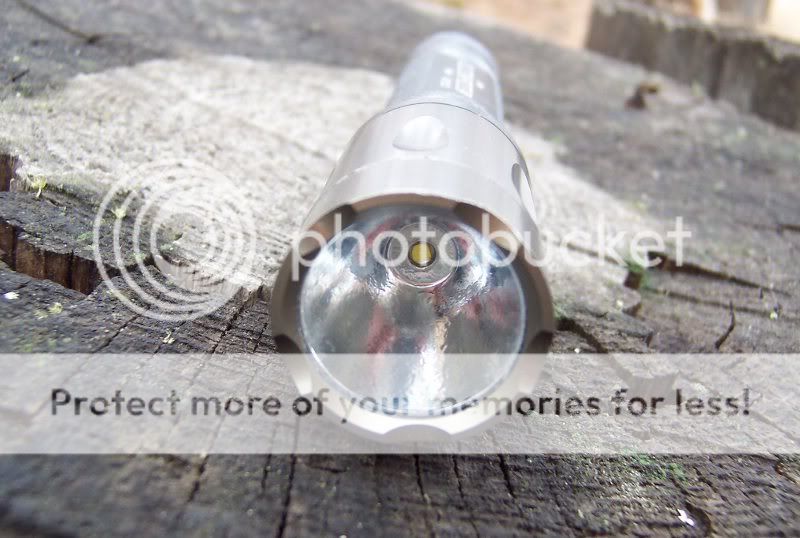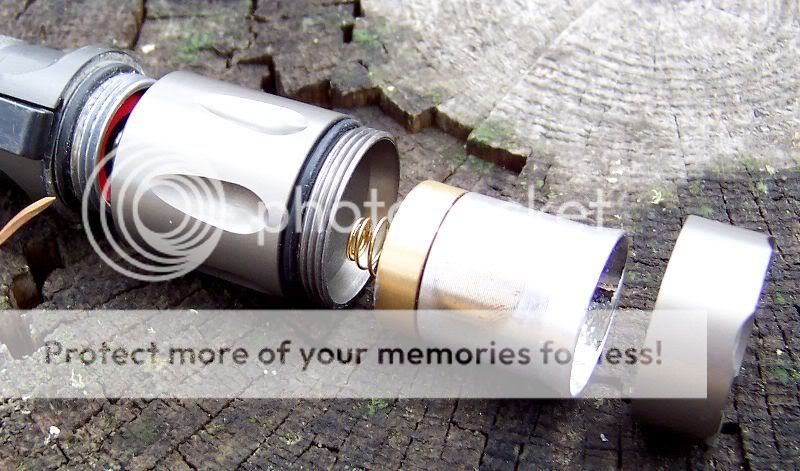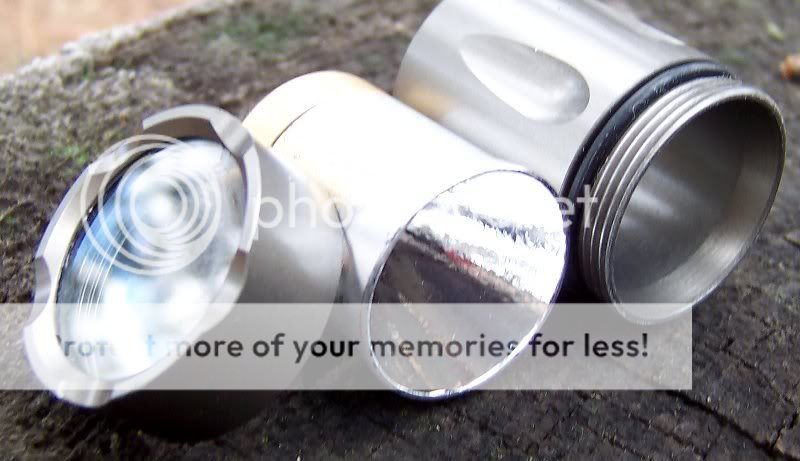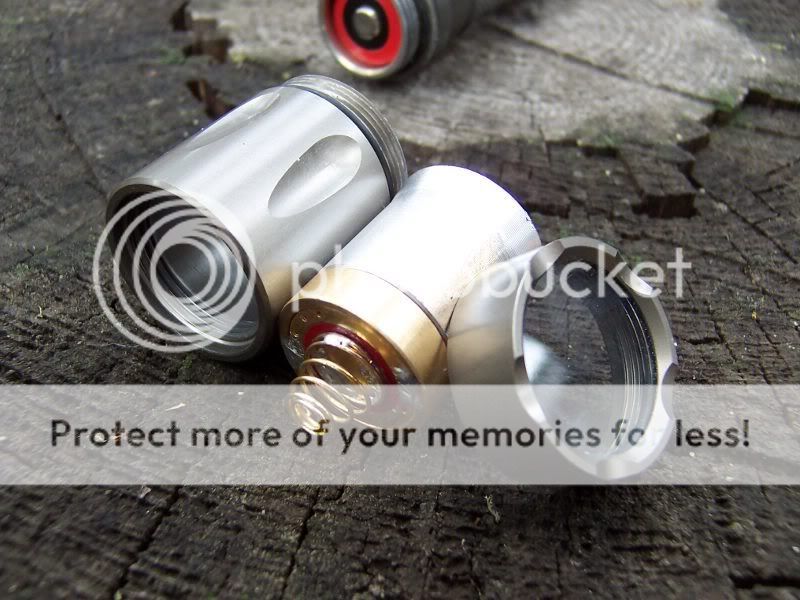mdocod
Flashaholic
The following is submitted as a review/overview. Moderators feel free to place it in the review area of the forum if you see fit.

LumensFactory will be releasing this product here shortly. It is a modular head unit that fits on the business end of any SureFire E series body. It should also theoretically fit on any after-market E series as well. The model I was sent for review is the 3.7V-9V rated (buck regulated) 3 mode w/memory.
--------------------------------------
Here's the manufacture specifications:
-High Output Cree XP-G, R5 LED
-3.7V to 9V Regulated Input for Maximum Flexibility
-3 Mode with Memory (5%-30%-100%)
-Maximum Current Input to LED at 1000mA
(Not Overdriven to Ensure Maximum Durability and Reliability)
-HA 3 Anodizing on the Head Unit.
-Constant Output
-Unique Reflector Design
-Precision Machined Aluminum Reflector
-High Temperature Resistant Light Orange Peel Coating
-Every Reflector Module is Pre-Focused for the Ultimate Spot
-Compatible with all Flashlights with E Series Sized Head Units.
Compatible with:
Surefire®
E1, E1E using 1 x RCR123A Rechargeable
E2, E2E, E2D, E2O using 2 x CR123A Primary Cells or 1 x 17670 Rechargeable Cell or 2 x RCR123A Rechargeable Cells
**Warning: Please use CR123a Lithium Batteries or Li-Ion 3.7V Rechargeable Batteries Only. Do NOT use IMR Battery setups**
---------------------------------------
The manufacture specs are not claiming any particular output. Just listing the drive level and LED type and bin. Based on the LED bin and drive level it should be respectably bright, and if I had to be the judge I would say it's a real performer. Coming from R2s of the past, I am pleasantly surprised.
The "not overdriven to ensure maximum durability" note in the specs is a little silly to even point out if you ask me. The unit would possibly run into thermal problems if driven to the full 1.5A, for reasons that will become apparent further in the review.
The listed compatibility with 17670 cells is only true if you are lucky enough to have an E body that will actually fit a 17670 size cell. That's a very hit and miss thing and more often than not it is a miss. A 14670 as an alternative is worth a look but won't really provide any more stored energy than a pair of RCR123s anyways. I haven't yet tested whether or not the 3.7-9V unit operates at full output on a single cell or not. Hopefully I will have a chance to do that and edit in my results in the coming days.
The recommendation against using IMR cells is probably a smart rule to folllow on the 2 cell applications, because a buck regulator like this can over-discharge unprotected cells long before there is any indication of performance loss. Stick to either CR123 primary cells or protected li-ion cells when using a pair of cells to drive the unit. For a single cell situation, I can't see any reason that a single IMR cell would be a major problem. Dimming should be noticeable before it has been severely over-discharged.
The latest generation of multi-mode drivers that LF is implementing (3.7V-9/13V instead of 6V-13V) seem to be a noteworthy improvement over the previous offering. In the 2 weeks or so that I have been using the light daily, I keep noticing how much better the multi-mode is behaving than in previous multi-mode "drop-ins" I have used. The memory catches on faster, and I only seem to get mode-changes when I want them rather than accidentally now. It's just a better timing/mapping and it's a welcome improvement. I'm normally not a fan of multi-mode unless it's on a headlamp or a 2 mode bezel twister with tail-clicker. This is the first multi-mode of this type that I have actually enjoyed using rather than being bothered by it. The 5% and 30% modes are produced via PWM at a high enough frequency so as not to be a bother unless you are purposely waving an object around in the light very quickly. As far as the outputs available in each mode, I would personally much rather see something like 1% (or less), 10%, and 100% as the distribution. The low on these 5% type units never seems low enough. I still find myself using my hand over the bezel as a damper to reduce output when trying to use the light in the bedroom at night, so as not to disturb my spouse. Even a fraction of a lumen is plenty for the low mode of a light, in the case of this multi-mode, the low mode is probably ~15 lumens, which is way overkill for a "low" mode IMO. (the "low" mode is brighter than a typical 2AA incan).
As you can probably see in the picture above, the color of the hard anodize is lighter than my E2E. This has been typical of HA LF products. Considering that the E series of lights are often considered by their owners to be more "dressy" or "classy" lights, I would have much preferred to see the HA tuned to be a few shades darker to better match the average SF body.
-----------------------------------------------

The reflector is fairly deep and narrow with an orange peel texturing. The beam produced by the arrangement is a great general purpose close to medium range beam. There is a soft very bright center spot with a soft transition to a bright and relatively wide corona that again fades softly to a spill that is gradually dimmer towards the edges. It's a very functional beam pattern that would be described by most as floody in the main action (spot plus corona combine to be a "wide" effective beam) and narrow in the spillbeam (deep reflector limits the maximum spill beam angle). Great for full target identification at indoor or close proximity outdoor ranges (~3-15 meter), or general outdoor navigation (up to maybe ~50 meter).
-------------------------------------

Perhaps the most important aspect of this unit, is the fact that it is not just a complete head replacement, it is actually part of a new modular type system that involves "lamp assemblies" and a head to hold hose LAs. As you can see in the picture above, the head is actually made up of several components. Once the head has been installed, removing the "bezel" of that head unit is like taking the head off of a D26 based light, granting access to the swapping of lamp modules. Over the long term, the customer should have the option to upgrade to newer LED modules at a reasonable price. The brass pill at the base of the reflector also un-screws from the reflector (production units may or may not have thread-locker on them). It wouldn't be too aweful hard for someone skilled with a soldering iron to go in and upgrade emitters in this unit down the road the same way that many people work on D26 based modules with brass "pills."
Initially, there will also be a 3.0-3.7V module available for this head which can operate from a single CR123 or RCR123 or 14670/17670 (depending on what fits). I do not have this module here for testing but would suggest against using unprotected li-ion cells with it. As described, it will likely be capable of over-discharging an unprotected li-ion cell.
I'm under the impression that we can expect updated modules available as newer LEDs become available. Also, I am under the impression that there might be a high CRI and/or warm tint modules available someday. (crossing fingers!)

The threads on the unit aren't the best, but work fine. They are on par with the typical Seraph/SolarForce type gear which is adequate for most peoples demands. Smooth enough to work reliably. One important thing to note though, is that the flange at the base of the head that overlaps and "crimps" over the E series O-ring is a tight fit over the O-Ring (tighter than SF stock E series heads). It would be advisable to keep the O-ring well lubed to prevent damage to the O-ring. The seal should be very good here, but since the E series does require the removal of the head to replace batteries, there is apt to be increased wear and tear on that O-ring.
As I understand, these units are likely shipping with the LF usual "hand selected" lower CCT LEDs in the cool white range. Typically down in the 5-6K range, which gives them a nice white appearance that isn't blueish. This has been a common practice for LF made drop-ins in the past and it seems to be continued with these. The unit I received appears to my eyes to be around the 5K range and looks great in use.

When the module is assembled with the lamp-assembly inside, but not installed on the body of the flashlight, the lamp-assembly does rattle around a bit in the head. This may come across to some users as being a bit cheesy. When the head is installed on the body of the flashlight, the perimeter of the base of the lamp-assembly is pressed tightly against the face of the threaded head of the body, this drives the lamp-assembly "home" into a centering O-ring that is seated up at the lens. This locks the lamp assembly solid into position. Think of it as having a D26 lamp sitting in the "head" of a D26 based light. They are just loosely sitting in there until screwed down onto the body which provides the tension to hold everything in place. Once installed, it's solid.
In the same fashion that a typical D26 module really only has a thermal path to the body where the base of the brass pill is pressed against the inside of the tapered aluminum body, this modules brass base is the primary thermal path to the body of the light. It's not the best thermal path, but it's a typical sacrifice we deal with for modular lamp-assembly based designs. It seems to work just fine. The efficiency of the R5 combined with what is seemingly a reasonably efficient regulator really helps to negate the limited thermal path from what I can tell. At 1A to the LED, I do not foresee a thermal problem problem here. I have run the light continuously for ~5 minutes and immediately pulled the module out after the run, the module was somewhat warm and heat seemed to have moved into the body well enough to protect the LED.
---------------------------------------
Overall I am excited to say that this seems like a good product worth a look for those with E series flashlights. A good come-back after the relatively disappointing SST-90 head release.
Eric

LumensFactory will be releasing this product here shortly. It is a modular head unit that fits on the business end of any SureFire E series body. It should also theoretically fit on any after-market E series as well. The model I was sent for review is the 3.7V-9V rated (buck regulated) 3 mode w/memory.
--------------------------------------
Here's the manufacture specifications:
-High Output Cree XP-G, R5 LED
-3.7V to 9V Regulated Input for Maximum Flexibility
-3 Mode with Memory (5%-30%-100%)
-Maximum Current Input to LED at 1000mA
(Not Overdriven to Ensure Maximum Durability and Reliability)
-HA 3 Anodizing on the Head Unit.
-Constant Output
-Unique Reflector Design
-Precision Machined Aluminum Reflector
-High Temperature Resistant Light Orange Peel Coating
-Every Reflector Module is Pre-Focused for the Ultimate Spot
-Compatible with all Flashlights with E Series Sized Head Units.
Compatible with:
Surefire®
E1, E1E using 1 x RCR123A Rechargeable
E2, E2E, E2D, E2O using 2 x CR123A Primary Cells or 1 x 17670 Rechargeable Cell or 2 x RCR123A Rechargeable Cells
**Warning: Please use CR123a Lithium Batteries or Li-Ion 3.7V Rechargeable Batteries Only. Do NOT use IMR Battery setups**
---------------------------------------
The manufacture specs are not claiming any particular output. Just listing the drive level and LED type and bin. Based on the LED bin and drive level it should be respectably bright, and if I had to be the judge I would say it's a real performer. Coming from R2s of the past, I am pleasantly surprised.
The "not overdriven to ensure maximum durability" note in the specs is a little silly to even point out if you ask me. The unit would possibly run into thermal problems if driven to the full 1.5A, for reasons that will become apparent further in the review.
The listed compatibility with 17670 cells is only true if you are lucky enough to have an E body that will actually fit a 17670 size cell. That's a very hit and miss thing and more often than not it is a miss. A 14670 as an alternative is worth a look but won't really provide any more stored energy than a pair of RCR123s anyways. I haven't yet tested whether or not the 3.7-9V unit operates at full output on a single cell or not. Hopefully I will have a chance to do that and edit in my results in the coming days.
The recommendation against using IMR cells is probably a smart rule to folllow on the 2 cell applications, because a buck regulator like this can over-discharge unprotected cells long before there is any indication of performance loss. Stick to either CR123 primary cells or protected li-ion cells when using a pair of cells to drive the unit. For a single cell situation, I can't see any reason that a single IMR cell would be a major problem. Dimming should be noticeable before it has been severely over-discharged.
The latest generation of multi-mode drivers that LF is implementing (3.7V-9/13V instead of 6V-13V) seem to be a noteworthy improvement over the previous offering. In the 2 weeks or so that I have been using the light daily, I keep noticing how much better the multi-mode is behaving than in previous multi-mode "drop-ins" I have used. The memory catches on faster, and I only seem to get mode-changes when I want them rather than accidentally now. It's just a better timing/mapping and it's a welcome improvement. I'm normally not a fan of multi-mode unless it's on a headlamp or a 2 mode bezel twister with tail-clicker. This is the first multi-mode of this type that I have actually enjoyed using rather than being bothered by it. The 5% and 30% modes are produced via PWM at a high enough frequency so as not to be a bother unless you are purposely waving an object around in the light very quickly. As far as the outputs available in each mode, I would personally much rather see something like 1% (or less), 10%, and 100% as the distribution. The low on these 5% type units never seems low enough. I still find myself using my hand over the bezel as a damper to reduce output when trying to use the light in the bedroom at night, so as not to disturb my spouse. Even a fraction of a lumen is plenty for the low mode of a light, in the case of this multi-mode, the low mode is probably ~15 lumens, which is way overkill for a "low" mode IMO. (the "low" mode is brighter than a typical 2AA incan).
As you can probably see in the picture above, the color of the hard anodize is lighter than my E2E. This has been typical of HA LF products. Considering that the E series of lights are often considered by their owners to be more "dressy" or "classy" lights, I would have much preferred to see the HA tuned to be a few shades darker to better match the average SF body.
-----------------------------------------------

The reflector is fairly deep and narrow with an orange peel texturing. The beam produced by the arrangement is a great general purpose close to medium range beam. There is a soft very bright center spot with a soft transition to a bright and relatively wide corona that again fades softly to a spill that is gradually dimmer towards the edges. It's a very functional beam pattern that would be described by most as floody in the main action (spot plus corona combine to be a "wide" effective beam) and narrow in the spillbeam (deep reflector limits the maximum spill beam angle). Great for full target identification at indoor or close proximity outdoor ranges (~3-15 meter), or general outdoor navigation (up to maybe ~50 meter).
-------------------------------------

Perhaps the most important aspect of this unit, is the fact that it is not just a complete head replacement, it is actually part of a new modular type system that involves "lamp assemblies" and a head to hold hose LAs. As you can see in the picture above, the head is actually made up of several components. Once the head has been installed, removing the "bezel" of that head unit is like taking the head off of a D26 based light, granting access to the swapping of lamp modules. Over the long term, the customer should have the option to upgrade to newer LED modules at a reasonable price. The brass pill at the base of the reflector also un-screws from the reflector (production units may or may not have thread-locker on them). It wouldn't be too aweful hard for someone skilled with a soldering iron to go in and upgrade emitters in this unit down the road the same way that many people work on D26 based modules with brass "pills."
Initially, there will also be a 3.0-3.7V module available for this head which can operate from a single CR123 or RCR123 or 14670/17670 (depending on what fits). I do not have this module here for testing but would suggest against using unprotected li-ion cells with it. As described, it will likely be capable of over-discharging an unprotected li-ion cell.
I'm under the impression that we can expect updated modules available as newer LEDs become available. Also, I am under the impression that there might be a high CRI and/or warm tint modules available someday. (crossing fingers!)

The threads on the unit aren't the best, but work fine. They are on par with the typical Seraph/SolarForce type gear which is adequate for most peoples demands. Smooth enough to work reliably. One important thing to note though, is that the flange at the base of the head that overlaps and "crimps" over the E series O-ring is a tight fit over the O-Ring (tighter than SF stock E series heads). It would be advisable to keep the O-ring well lubed to prevent damage to the O-ring. The seal should be very good here, but since the E series does require the removal of the head to replace batteries, there is apt to be increased wear and tear on that O-ring.
As I understand, these units are likely shipping with the LF usual "hand selected" lower CCT LEDs in the cool white range. Typically down in the 5-6K range, which gives them a nice white appearance that isn't blueish. This has been a common practice for LF made drop-ins in the past and it seems to be continued with these. The unit I received appears to my eyes to be around the 5K range and looks great in use.

When the module is assembled with the lamp-assembly inside, but not installed on the body of the flashlight, the lamp-assembly does rattle around a bit in the head. This may come across to some users as being a bit cheesy. When the head is installed on the body of the flashlight, the perimeter of the base of the lamp-assembly is pressed tightly against the face of the threaded head of the body, this drives the lamp-assembly "home" into a centering O-ring that is seated up at the lens. This locks the lamp assembly solid into position. Think of it as having a D26 lamp sitting in the "head" of a D26 based light. They are just loosely sitting in there until screwed down onto the body which provides the tension to hold everything in place. Once installed, it's solid.
In the same fashion that a typical D26 module really only has a thermal path to the body where the base of the brass pill is pressed against the inside of the tapered aluminum body, this modules brass base is the primary thermal path to the body of the light. It's not the best thermal path, but it's a typical sacrifice we deal with for modular lamp-assembly based designs. It seems to work just fine. The efficiency of the R5 combined with what is seemingly a reasonably efficient regulator really helps to negate the limited thermal path from what I can tell. At 1A to the LED, I do not foresee a thermal problem problem here. I have run the light continuously for ~5 minutes and immediately pulled the module out after the run, the module was somewhat warm and heat seemed to have moved into the body well enough to protect the LED.
---------------------------------------
Overall I am excited to say that this seems like a good product worth a look for those with E series flashlights. A good come-back after the relatively disappointing SST-90 head release.
Eric

